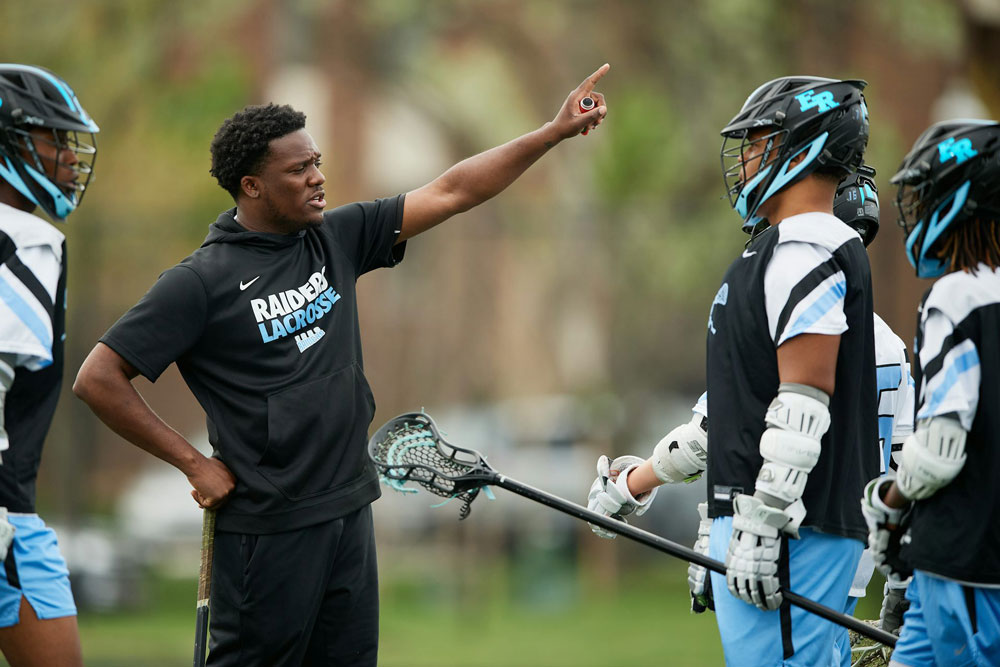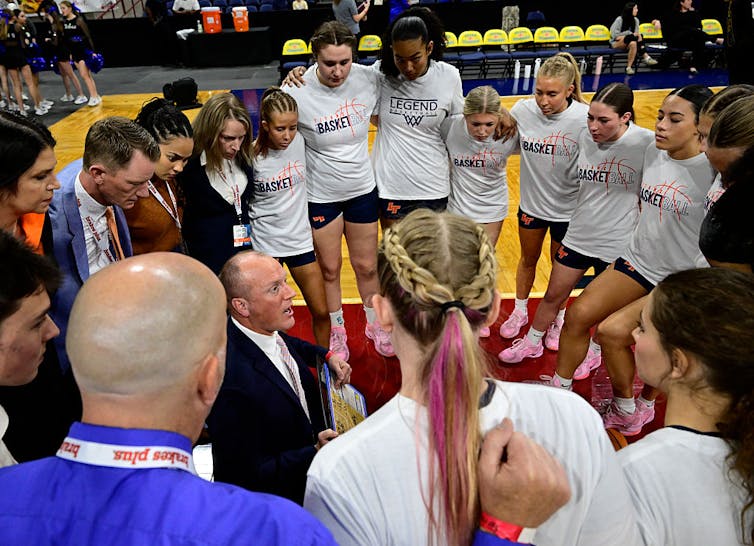
By Jedediah Blanton and Scott Pierce
Coach Smith was an easy hire as the head coach of a new high school lacrosse team in Tennesseee: She had two decades of coaching experience and a doctorate in sport and exercise science.
After signing the paperwork, which guaranteed a stipend of US$1,200, Smith – we’re using a pseudonym to protect her identity – had four days to complete a background check, CPR and concussion training and a Fundamentals of Coaching online course. After spending $300 to check all these boxes, the job was hers.
The Tennessee Secondary School Athletic Association’s mission statement highlights how high school athletes should be molded into good citizens and have their educational experiences enhanced by playing sports.
Yet Coach Smith hadn’t received any guidance on how to accomplish these goals. She didn’t know how a high school coach would be evaluated – surely it went beyond wins, losses and knowing CPR – or how to make her players better students and citizens.
Over the past 15 years, our work has focused on maximizing the benefits of high school sports and recognizing what limits those benefits from being reached. We want to know what high school sports aspire to be and what actually happens on the ground.
We have learned that Coach Smith is not alone; this is a common story playing out on high school fields and courts across the country. Good coaching candidates are getting hired and doing their best to keep high school sports fixtures in their communities. But coaches often feel like they’re missing something, and they wonder whether they’re living up to those aspirations.
Does the mission match reality?
Dating back to the inception of school-sponsored sport leagues in 1903, parents and educators have long believed that interscholastic sports are a place where students develop character and leadership skills.
Research generally backs up the advantages of playing sports. In 2019, high school sports scholar Stéphanie Turgeon published a review paper highlighting the benefits and drawbacks of playing school sports. She found that student-athletes were less likely to drop out, more likely to be better at emotional regulation and more likely to contribute to their communities. While athletes reported more stress and were more likely to drink alcohol, Turgeon concluded that the positives outweighed the negatives.
The governing body of high school sports in the U.S., the National Federation of State High School Associations, oversees 8 million students. According to its mission statement, the organization seeks to establish “playing rules that emphasize health and safety,” create “educational programs that develop leaders” and provide “administrative support to increase opportunities and promote sportsmanship.”
Digging deeper into the goals of sports governing bodies, we recently conducted a study that reviewed and analyzed the mission statements of all 51 of the member state associations that officially sponsor high school sports and activities.
In their missions, most associations described the services they provided – supervising competition, creating uniform rules of play and offering professional development opportunities for coaches and administrators. A majority aimed to instill athletes with life skills such as leadership, sportsmanship and wellness. Most also emphasized the relationship between sports and education, either suggesting that athletics should support or operate alongside schools’ academic goals or directly create educational opportunities for athletes on the playing field. And a handful explicitly aspired to protect student-athletes from abuse and exploitation.
Interestingly, seven state associations mentioned that sports participation is a privilege, with three adding the line “and not a right.” This seems to conflict with the National Federation of State High School Associations, which has said that it wants to reach as many students as possible. The organization sees high school sports as a place where kids can further their education, which is a right in the U.S. This is important, particularly as youth sports have developed into a multibillion-dollar industry fueled by expensive travel leagues and club teams.
We also noticed what was largely missing from these mission statements. Only two state athletic associations included a goal for students to “have fun” playing sports. Research dating back to the 1970s has consistently shown that wanting to have fun is usually the No. 1 reason kids sign up for sports in the first place.
Giving coaches the tools to succeed
Missions statements are supposed to guide organizations and outline their goals. For high school sports, the opportunity exists to more clearly align educational initiatives and evaluation efforts to fulfill their missions.
If high school sports are really meant to build leadership and life skills, you would think that the adults running these programs would be eager to acquire the skill set to do this. Sure enough, when we surveyed high school coaches across the country in 2019, we found that 90% reported that formal leadership training programs were a good idea. Yet less than 12% had actually participated in those programs.

Andy Cross/MediaNews Group/The Denver Post via Getty Images
A recent study led by physical education scholar Obidiah Atkinson highlighted this disconnect. While most states require training for coaches, the depth and amount of instruction varied significantly, with little emphasis on social–emotional health and youth development. In another study we conducted, we spoke with administrators. They admitted that coaches rarely receive training to effectively teach the leadership and life skills that high school sports promise to deliver.
This type of training is available; we helped the National Federation of State High School Associations create three free courses explicitly focused on developing student leadership. Thousands of students and coaches have completed these courses, with students reporting that the courses have helped them develop leadership as a life skill. And it’s exciting to see that the organization offers over 60 courses reaching millions of learners on topics ranging from Heat Illness Prevention and Sudden Cardiac Arrest, to Coaching Mental Wellness and Engaging Effectively with Parents.
Yet, our research findings suggest that if these aspirational missions are to be taken seriously, it’s important to really measure what matters.
Educational programs can be evaluated to determine whether and how they are helping coaches and students, and coaches ought to be evaluated and retained based on their ability to help athletes learn how to do more than kick a soccer ball or throw a strike. Our findings highlight the opportunity for high school athletic associations and researchers to work together to better understand how this training is helping coaches to meet the promises of high school sports.
Taking these steps will help to make sure coaches like Coach Smith have the tools, support and feedback they need to succeed.
![]()
Jedediah Blanton is Assistant Professor of Kinesiology and Recreation and Sport Studies at the University of Tennessee; Scott Pierce is Professor of Kinesiology and Recreation at Illinois State University.




























feddy says
High school sports will be ruined because of the NIL deals now allowed for high school athletes. All but 10 or 12 states allow high school athletes to receive NIL benefits. Some state have limitations on this but still allow.
JimboXYZ says
Most HS sports is nothing more than an after school hobby really. Mediocre athletes expecting to get paid like NCAA NIL contracts. It’s comical really that even the NCAA pays that. But at least with the NCAA the audiences are bigger than just the parents attending meaningless games that make for creating a local Al Bundy legend of a rare performance for stats. Gambling has become the only reason the NCAA & the Big 4-5 sports exists anymore. Other than that HS sports is just a little more competitive for an after school exercise program to manage diabetes. I get it though, the discipline to train, but is that really more about any child’s obsession for something that comes naturally easier. We just came out of a Biden-Harris era that was marked by men wanting to compete in Women’s divisions of HS & NCAA sports based upon gender identity issues. It became more about setting records against inferior competition, lowering the bar for a select few, raising it to overcome for the many that the whole concept of separate divisions was the common sense to fair competition.
Pogo says
@It’s only a game
… as stated:
https://www.google.com/search?q=draftkings+closing+price
Ray W. says
Over the years, I coached 12 recreational league baseball and softball teams and was an assistant on another 10 teams. Throughout those many years, it was common for parents of my more accomplished players to seek to have me coach in a way that would prepare their children for high school programs. I steadfastly maintained that I was coaching in a recreational league and that the Port Orange league philosophy was that all kids should get the chance to play as much as possible, not just the more accomplished kids. There was minor friction over my approach, but never acrimony. Besides, I understood their point.
But it didn’t take long for me to impose one practice on my teams. Knowing the hectic nature of early evening games, it was clear to me that some kids had not had time to eat before their parents came home and rushed them to a field for a 5:30 pm game. When I first met with parents prior to each new season, I told them that if everyone had arrived for a game and it was called on account of nearby lightning just before starting or early in the game, we would go as a team to a pizza place of the kid’s choosing. The kids almost invariably chose the old Steel City pizza location because there was a game room in the back. I used to opportunity to sit and talk with parents, table by table, while breaking bread.
One season a few years after my four kids had aged out of rec league ball, I received a call from Henrika, the deputy director of the city’s rec league program. She had more teams than coaches and asked would I come back. I agreed to take on a 9-10 kid pitch baseball team, as I recall. I didn’t know any of the parents of the kids on my team at the start of the season.
One boy, well-accomplished but undersized, had the misfortune of having parents fresh off a bitter divorce. The dad volunteered as an assistant coach. He and his wife sniped at each other from time to time during games, but not that often, she from the stands and he from the dugout. After a few games of this minor sniping, I intervened from a dugout filled with boys when the pair were yelling at each other while standing on opposite sides of the dugout chain-link fence. The wife loudly announced to me that she would yell when she wanted to.
The next morning, when I called the husband, he offered to quit as a volunteer. I accepted. Next, the wife still insisted to me that I had no right to interfere with how she acted at the ball field. I told her that I had not wanted to make a scene the night before in front of the team, but right now she needed to disabuse herself of the idea that I couldn’t have her ejected from the grounds if she continued to behave the way she had behaved the night before.
Both parents stopped coming to the games, which meant I had to pick up their son before each game and then return him home. The difference in the boy’s happiness at just playing without hearing the sniping was amazing; he became a different child.
As I was driving him home one evening, he told me that his best friend really wished I had chosen him, too, to play on my team. His best friend played on an undefeated team. Mine, as I recall, ended up 5-7 on the season. I asked why? He said that my team had already had three team pizza nights after rainouts, and that his best friend’s team had not had any pizza parties.
I knew that the kids just wanted to have fun. I knew that they just wanted to have pizza as a team. I knew that my job was to encourage all of my kids to play.
My team rule was that if a kid could defend himself or herself with a glove, that child would play at least one inning per game in the infield. But each had to play hard in practice to earn that right.
I knew that my most accomplished five or six players would match up with any other team’s most accomplished five or six players. The way to win, to me, was to get my least accomplished players interested in playing hard. If I could get my least accomplished players interested in playing harder than the other coaches’ least accomplished players, we stood a good chance of winning. Each pre-game, when I posted the chart of who would play where each inning, all of my players crowded around to see when they were playing in the infield.
Eight of my 10 boys teams made the playoffs. They won the championship more often than not. One of my two girl’s teams made the playoffs; they lost in the second round.
While other coaches catered to their sons and daughters and to the sons and daughters of their assistant coaches, my children did not start at the position where they wanted to play unless they were the best on the team at that position. If other kids were better, mine came in at that position for no more than one or two innings each game.
The kids knew I didn’t play favorites and they played hard just to get a chance to play in the infield or to pitch. One season I used 10 of my 13 boys on the mound. By the time we made the playoffs between NSB and Port Orange, we were prepared and we won all three of our playoff games, but the best boys at a position still did not play the whole game.
Yes, winning is important to kids, but it is not all-important. I kept telling parents that if their son or daughter could make a play three times out of 10 at the start of a season and four times out of 10 by the end of the season, then their child was 33% better than they had been when they started. That was enough for me and it should be enough for them. Don’t yell because someone makes a mistake. They can hear their parent’s voices and it hurts the children more than the parents know.
I began to ask each parent before the first practice of the new season if they understood the difference between constructive criticism and destructive criticism. I told them that they had permission to come into the dugout during games to offer constructive criticism, but there would be no offering of destructive criticism during a game, not even from the stands. I gave them my home number and told them they could call me at 3:00 in the morning with destructive criticism and I would listen, but I would not listen to that type of criticism during a game.
In time, I began to tell the parents that there were two types of rec league coaches in this world: those who had had a parent banned from a game and those who were going to have a parent banned from a game.
I suggested to the parents that if they thought they were the type of parent who might be banned from a game for rude or crude behavior then they should bring binoculars to each game so that after they were removed from the stands they could better watch the rest of the game from the parking lot.
A group of about eight ballplayers, including my two boys, remained friends from T-ball to long after high school. Now, near 40, some still get together from time to time. One of those boys flew out to San Diego when my younger son completed his five-year stint in the Navy. They drove back across the country together. Loyalty and friendship forged over many years playing ball. That young man is now a deputy sheriff.
Joe D says
For Ray W:
You should reprint your comment and hand it out to every league in the COUNTRY! What a WONDERFUL way to teach/coach and inspire new athletes.
I spent MOST of my WEEKEND mornings ( and frequently after school evenings from the time my 3 kids were 3 years old, through high school, running back and forth for sports practice and games ( boys and girls soccer, baseball, basketball, swimming, girls Lacrosse) my oldest son was on a regional championship soccer team and a regional swimming champion, and my daughter was a FOX Prep Player of the Week as the Goalie of her high school Lacrosse team.
Yes, the KIDS just want to have FUN…,but as a Child and Family Nurse Therapist, I agree with you about inappropriate behavior of SOME parents aimed at VOLUNTEER COACHES…and FREQUENTLY yelling CRITICISMS at their OWN child from the sidelines! I SERIOUSLY had to bite my tongue, as I watched those children “deflate” in their parent’s disapproval.
None of my kids became PROFESSIONAL athletes, but the self discipline, team work and commitment skills they learned have lasted long into adulthood.
Now I spend my weekend mornings and some after school evenings watching my 3 out of 4 grandsons ( the youngest is too young to play, as is my 18 month granddaughter) play soccer, baseball and basketball 🥰
Ray W. says
Hello Joe D:
I applaud you for your continuing dedication to your community and your family.
I didn’t seek to coach a team until after four seasons serving as an assistant coach. I watched and listened. I asked the coaches how they wanted me to coach various drills. Finally, I stepped in as a head coach. But I never stopped watching and listening and asking questions. Much of what I described in my comment above was absorbed from my watching and listening to other coaches. Much was learned on my own.
My four children played soccer and basketball, but I didn’t even attempt to help coach those sports.